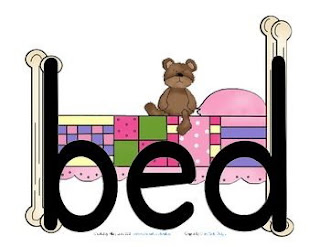The "bed" Strategy
This simple strategy for recognizing and writing b and d give students an image to hold in their memories and a gesture they can make with their hands. Show your child the picture of the bed, emphasizing the /b/ sound when you point to the b and the /d/ sound when you point to the d. Show him how to hold his hands to make his own bed image. When he is writing and comes to a word that uses either b or d, ask him to look at the image (or, better yet, close his eyes and see it in his mind) or hold his hands in position to remind him which letter to use.
Recruit the Gross Motor System
Writing very large letters/numbers employs the gross motor system, strengthening a child’s memory for the sequences of movements needed to form letter and numbers. Kids think it’s fun, too! Using a wet sponge on a sidewalk, sidewalk chalk, a dry erase marker or chalk, challenge your child to write individual letters, numbers, or words that use problematic letters. You could also try “sky-writing,” in which a child uses her finger or whole hand to “write” in the air. Be sure she follows the sequence of motions she’d use to form the letters and numbers if she were using a pencil.
Make It Tactile
Feeling different textures can be useful in learning letter and number formation by underscoring the tactile experience of learning (rather than the largely visual experience that most children get). Your child can trace letters in a sand tray, on a piece of sandpaper, or on the carpet. He might also “write” in a layer of shaving cream spread on a table.
Another way to make letter formation tactile is to help your child form letters and numbers from clay or pipe cleaners. You could even use cookie dough and bake your child’s work – yum!
Make it Playful
This will sound familiar if you read our sight word posts. Your child might enjoy guessing games that require her to identify letters and numbers by how their shapes feel. A simple way to do this is to trace letters or on her back and ask her to say what has been written. She can also trace letters on an adult’s back for them to guess.
Another guessing game requires some set-up: Glue foam or wooden letters or numbers on pieces of card stock and add a line for the letter/number to sit on with a line of glue or puff paint (so that your child can feel which way the letter should be oriented). The cards can be put into a bag or box. With her eyes closed, ask your child to draw one out, feel it, and say which number/letter she is holding.



No comments:
Post a Comment